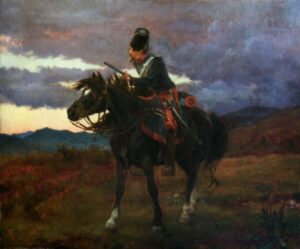Butler, Lady Elizabeth Southerden (1846-1933)
Elizabeth Southerden Thompson (1846 -1933) was one of the most famous female painters of the day, whose name was known throughout the whole of England and its colonies. She showed a strong aptitude at a young age for painting horses and soldiers, and was one of the first female artists to achieve fame in painting military and historical subject matter. She travelled abroad and studied with Giuseppe Bellucce in Florence and Rome, before finally taking some instruction at the South Kensington School of Art, London. Her reputation was sealed when her painting of Roll Call was exhibited at the Royal Academy in 1874, which was subsequently bought by Queen Victoria and still remains in the Royal Collection. Roll Call depicts the remnants of a Battalion of Grenadier Guards who remained standing in the aftermath of what is believed to be the Battle of Inkerman in 1854. This battle took place during the Crimean War which was a long lasting conflict between the Russian, French and British Empires, as well as the Kingdom of Sardinia who were all vying for control over the territories of the waning Ottoman Empire. Thompsons painting illustrates the cruel realities of war while still capturing the viewer with its beauty of composition, paint handling, and its success in portraying the individual personalities of the troops. The commander sits uninjured on his horse and looks down examining the remaining men after ordering them to line up for roll call. The second in command takes notes while the tired and injured soldiers try to keep on their feet. One of the men, with a pale pallor, has fallen and his comrade is checking to see if he is still alive.
In 1874 when this painting was created, there was an increasing awareness of social injustice and the need for many political reforms. The artists and writers of the day played a major role in spreading this awareness that eventually lead to the bettering of working conditions both for the general population and the military. In her 1922 autobiography, the artist recalled that she “…never painted for the glory of war, but to portray its pathos and heroism…” Thompson married a Lieutenant General, Sir William Butler, in 1877 and in 1879 started signing her name as Lady Butler. Her work received much praise from several important artists of the day including Édouard Detaille an important student of Jean-Louis-Ernest Meissonier and John Ruskin, the famous art critic, who noted on her painting at the Royal Academy exhibition of 1876 that he “had seen nothing like it since the death of Turner as colour intensity and truth of gradation.” Thomson is one of many artists brushed aside with the insurgence of the modernist sensibilities, but whose accomplishments both as a woman and an artist should not be forgotten.
Showing the single result
